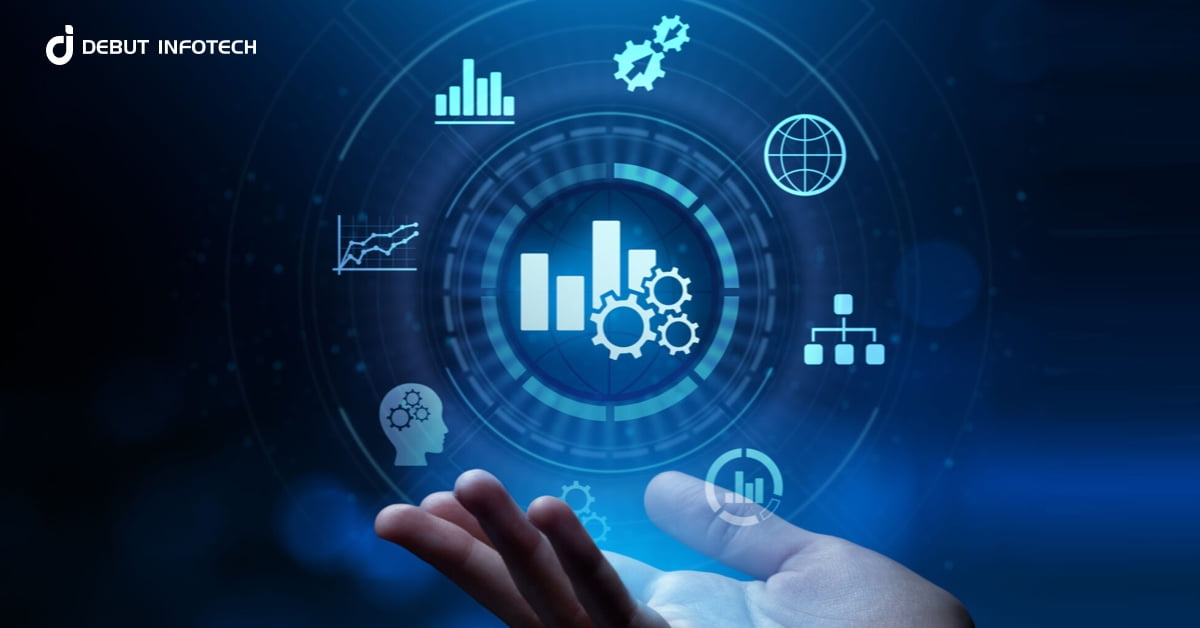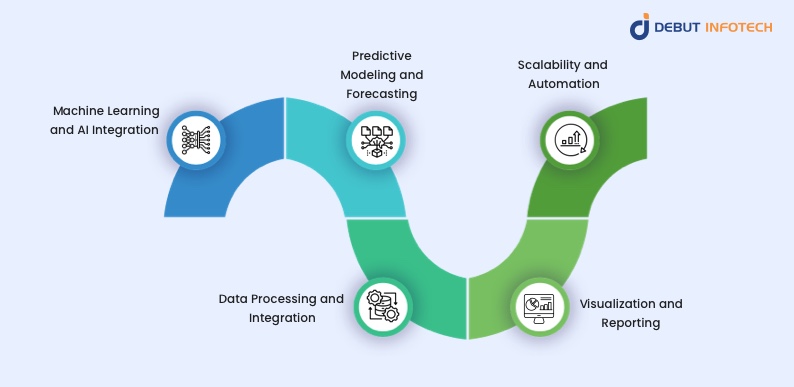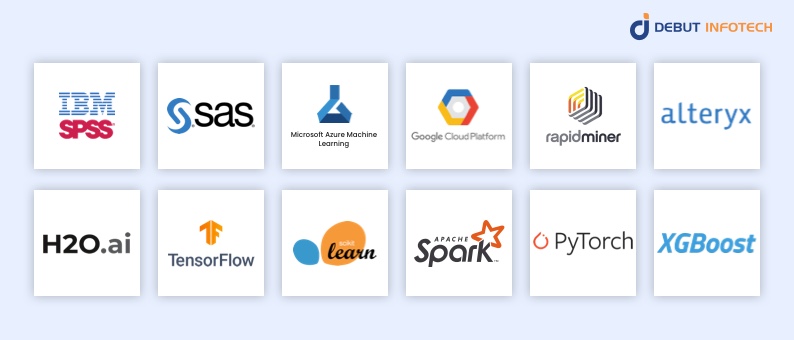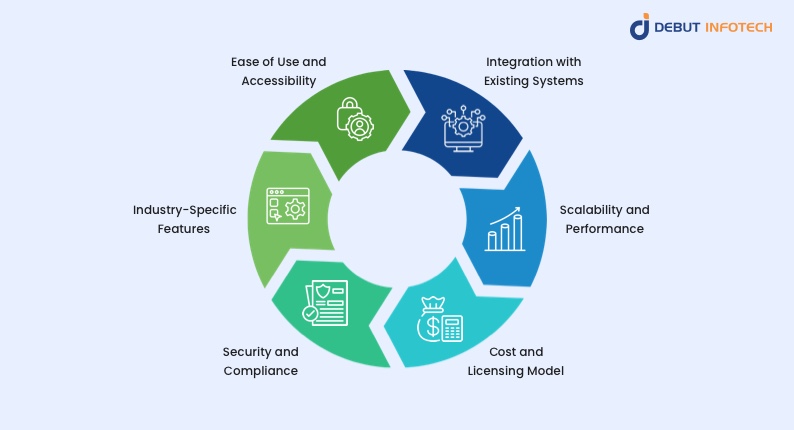Table of Contents
Home / Blog / AI/ML
The Ultimate Guide to Predictive Analytics Tools and Frameworks
February 24, 2025

February 24, 2025
Predictive analytics tools and frameworks have radically changed the way businesses use data to forecast trends, refine strategies, and make data-driven decisions. Such solutions leverage machine learning, statistical modeling, or artificial intelligence to examine historical data and provide actionable insights.
The size of the global predictive analytics market was valued at $10.5 billion in 2021 and is expected to reach $28.1 billion by 2026, at a CAGR of 21.7% during the forecast period. This shows the increasing adoption of artificial intelligence (AI) and machine learning (ML) technologies across various industries.
Predictive analytics helps organizations across industries—finance, healthcare, marketing, and logistics—to improve efficiency and competitive advantage. In 2023, about 66% of U.S. healthcare organizations were using predictive analytics to predict patient outcomes and service delivery. What’s more, over 55% of organizations will utilize AI-powered predictive analytics tools by 2025 to improve decision-making and operational efficiency, especially in finance, marketing, and supply chain management.
In this article, we will shed light on the definition of predictive analytic tools and frameworks, as well as their benefits, features, and factors to consider when choosing one. Furthermore, we will reveal the top 15 predictive analytic tools and frameworks.
Stop Guessing, Start Predicting!
Get ahead of the game with our predictive analytics solutions. Make smarter decisions, minimize risks, and stay one step ahead of the competition. Let’s turn your data into real business intelligence.
What Are Predictive Analytics Tools and Frameworks?
Predictive analytics tools and frameworks are software solutions that use historical data to forecast future outcomes through statistical algorithms, machine learning, and artificial intelligence. These tools allow organizations to recognize patterns, evaluate risks, and make more accurate data-driven decisions.
Predictive analytics tools analyze huge amounts of structured and unstructured data and turn the raw data into actionable insights. They integrate with business intelligence platforms, databases, and cloud services to deliver real-time predictions. Many modern tools include automation capabilities, enabling businesses to streamline operations and reduce human intervention in data analysis.
On the other hand, Frameworks provide a more structured environment for building predictive models. Most predictive analytics solutions/frameworks are usually open-source or proprietary libraries targeted at data scientists and analysts. They offer ready-made AI algorithms, customizable modeling approaches, and deployment methods to streamline the creation, training, and improvement of predictive models.
What Are the Key Features of Predictive Analytics Tools?
With a variety of features aimed at optimizing forecasting and analytics for data-driven decision-making, modern predictive data analytics tools cater to a breadth of needs. These include:

1. Machine Learning and AI Integration
Predictive analytics tools leverage machine learning and AI to automate data analysis, identify patterns, and generate accurate forecasts. Advanced machine learning algorithms continuously learn from new data, improving prediction quality over time. This feature is crucial for fraud detection, demand forecasting, and personalized recommendations in industries such as finance, healthcare, and e-commerce.
2. Data Processing and Integration
Effective predictive analytics relies on clean, structured data from multiple sources. These tools support real-time data ingestion, preprocessing, and integration with databases, cloud storage, and third-party applications. Seamless data integration enhances model accuracy and efficiency, enabling businesses to generate insights from diverse datasets, including transactional, social media, and IoT data.
3. Predictive Modeling and Forecasting
These tools use statistical techniques such as regression analysis, time-series forecasting, and deep learning to predict future trends. By analyzing historical data, predictive modelling tools help businesses optimize supply chains, assess financial risks, and improve customer retention. Organizations can test different models, refine variables, and enhance decision-making based on high-accuracy predictions.
4. Visualization and Reporting
Interactive dashboards, real-time charts, and automated reporting features enable users to interpret predictive insights without deep technical expertise. Data visualization tools highlight key trends, outliers, and correlations, making it easier for stakeholders to act on findings. Industries such as marketing, healthcare, and finance use these capabilities for strategic planning.
5. Scalability and Automation
Predictive analytics engines are designed to handle large datasets and automate repetitive tasks such as data cleansing, model training, and result interpretation. Machine learning consulting firms leverage cloud-based solutions to provide scalable computing power, ensuring fast processing of complex models. Automated workflows streamline operations, reducing manual effort and allowing teams to focus on strategic decision-making.
Benefits of Using Predictive Analytics Tools and Frameworks
Implementing predictive analytics tools and frameworks helps businesses make proactive, data-driven decisions. Here are some benefits:
1. Improved Decision-Making
Predictive analytics enhances decision-making by providing data-backed forecasts, reducing uncertainty, and identifying emerging trends. Businesses can anticipate market shifts, customer preferences, and operational risks. With real-time insights, organizations make informed strategic choices, optimizing processes and resource allocation for greater efficiency and competitive advantage across industries like finance, healthcare, and retail.
2. Increased Operational Efficiency
By automating data analysis and forecasting, predictive analytics tools minimize manual effort, improve workflow efficiency, and reduce errors. Organizations can streamline supply chains, enhance inventory management, and optimize resource utilization. This results in lower operational costs and better productivity, making predictive analytics software essential for industries such as manufacturing, logistics, and telecommunications.
3. Enhanced Customer Insights
Businesses can analyze customer behavior, preferences, and buying patterns to create personalized experiences and targeted marketing strategies. A top-notch AI development company such as Debut Infotech can help build predictive models that assist in customer segmentation, churn prediction, and sentiment analysis, allowing companies to enhance engagement and satisfaction. Retailers, financial institutions, and e-commerce platforms leverage these insights to boost customer retention and drive revenue growth.
4. Risk Reduction and Fraud Prevention
Predictive analytics detects anomalies, flags suspicious activities, and identifies potential risks before they escalate. Financial institutions use it for fraud detection, while insurers assess claim validity. Healthcare providers predict patient risks, and cybersecurity teams identify threats in real-time. By mitigating risks early, businesses enhance security, compliance, and overall stability.
Top 12 Predictive Analytics Tools and Frameworks
Predictive analytics tools and frameworks allow businesses and researchers to leverage data to drive insights, automate forecasting, and assist in optimizing decisions. While the tools for predictive analytics come loaded with features and require minimal coding, the frameworks provide flexibility for developing custom models.

Here are 12 popular solutions, including their capabilities, intended users, and industry applications:
1. IBM SPSS Modeler
IBM SPSS Modeler is a powerful software for predictive analytics tool known for its intuitive drag-and-drop interface and strong statistical modeling capabilities. Designed for business analysts and data scientists, it supports machine learning, decision trees, and neural networks. Its strength lies in advanced automation, reducing the need for coding.
Widely used in finance, healthcare, and retail, SPSS helps businesses with fraud detection, risk assessment, and customer segmentation, providing actionable insights to improve decision-making and operational efficiency.
2. SAS Advanced Analytics
SAS Advanced Analytics is an enterprise-grade solution with robust statistical modeling and machine learning features. Its strengths include scalability, high-performance data processing, and industry-specific applications. Based on demand, machine learning development companies often integrate SAS into the solutions of large organizations and data professionals, particularly in the banking, healthcare, and government sectors. It supports fraud detection, regulatory compliance, and risk management. With its AI-driven capabilities, SAS helps businesses analyze complex datasets, optimize financial strategies, and enhance predictive accuracy for data-driven decision-making.
3. Microsoft Azure Machine Learning
Azure Machine Learning is a cloud-based predictive analytics platform that integrates with Microsoft’s ecosystem. It provides automated ML, drag-and-drop tools, and support for open-source frameworks like TensorFlow and Scikit-learn. As part of the best predictive analytics software, Its strength lies in its scalability and ease of deployment. Businesses, developers, and data scientists use Azure ML for customer churn analysis, predictive maintenance, and financial forecasting.
4. Google Cloud AI Platform
Google Cloud AI Platform offers a suite of machine learning tools for predictive modeling and AI deployment. It integrates seamlessly with TensorFlow, AutoML, and BigQuery, making it a strong choice for data scientists and developers. Known for its powerful cloud computing capabilities, it supports industries like healthcare, retail, and finance. Companies use it for customer segmentation, fraud prevention, and demand forecasting. Its advanced automation and AI-driven insights help organizations scale predictive analytics efficiently.
5. RapidMiner
RapidMiner is a no-code predictive analytics platform that simplifies machine learning and data mining. Its user-friendly interface allows non-technical users to build predictive models without programming knowledge. It excels in automation and visualization, making it ideal for business analysts and educators. RapidMiner is widely used in marketing, finance, and healthcare for fraud detection, risk assessment, and customer behavior analysis. Its strength lies in rapid model development, enabling organizations to drive data-driven decisions efficiently.
6. Alteryx Predictive Analytics
Alteryx combines data preparation, machine learning, and predictive analytics in an easy-to-use platform. This predictive analytics software caters to analysts and business professionals with minimal coding experience. Known for automation and workflow integration, it helps users process large datasets efficiently. Alteryx is commonly used in retail, healthcare, and logistics for demand forecasting, fraud detection, and customer analytics. Its scalability and automation make it a strong tool for organizations aiming to streamline data analysis and improve operational efficiency.
7. H2O.ai
H2O.ai is an open-source, AI-powered platform that excels in machine learning automation. Its strength lies in AutoML capabilities, enabling businesses to build predictive models with minimal manual effort. Designed for enterprises and data scientists, H2O.ai is used in banking, telecommunications, and insurance for credit scoring, fraud detection, and customer retention strategies. Its scalable infrastructure supports high-speed processing, making it an excellent choice for organizations handling vast amounts of data.
8. TensorFlow (Framework)
TensorFlow is an open-source machine learning framework developed by Google. It is renowned for its deep learning capabilities and supports large-scale AI applications. Used by developers, researchers, and enterprises, TensorFlow powers applications such as speech recognition, healthcare diagnostics, and financial forecasting. Its flexibility and scalability make it a top choice for businesses building custom AI prediction tools and models.
9. Scikit-learn (Framework)
Scikit-learn is a Python-based machine-learning library that provides efficient implementations of regression, classification, clustering, and dimensionality reduction. It is widely used in academia and industry for predictive analytics in finance, healthcare, and marketing. Scikit-learn’s strength lies in its simplicity. This makes it ideal for data scientists and analysts working on customer segmentation, fraud detection, and risk analysis.
10. Apache Spark MLlib (Framework)
Apache Spark MLlib is a machine learning library designed for big data processing. It supports distributed computing, making it ideal for large-scale predictive analytics. Its scalability and speed make it a preferred choice for industries like finance, telecommunications, and cybersecurity. Organizations use Spark MLlib for fraud detection, anomaly detection, and predictive maintenance in real-time applications.
11. PyTorch (Framework)
PyTorch is an open-source deep-learning framework developed by Facebook. It is widely used for predictive analytics in industries such as healthcare, robotics, and finance. PyTorch’s dynamic computation graph and strong neural network capabilities make it ideal for image recognition, anomaly detection, and predictive diagnostics. Many businesses rely on machine learning development services to harness PyTorch’s flexibility, enabling researchers and developers to build advanced AI models efficiently.
12. XGBoost (Framework)
XGBoost is a high-performance machine learning library known for its speed and accuracy in predictive modeling. It excels in gradient boosting and is widely used in fintech, insurance, and e-commerce for fraud detection, credit scoring, and customer behavior analysis. XGBoost’s ability to handle missing data and large datasets makes it a preferred choice for data science competitions and real-world applications.
How to Choose the Right Predictive Analytics Tool
Choosing the best predictive analytics tool requires evaluating various factors to align with business goals, technical requirements, and industry needs. Here are some factors to consider when choosing predictive AI tools:

1. Ease of Use and Accessibility
A user-friendly interface and low-code/no-code capabilities enable business users and analysts to build predictive models without extensive technical expertise. Tools with intuitive dashboards, drag-and-drop features, and pre-built templates streamline adoption. Organizations should assess whether the platform provides self-service analytics for non-technical teams or requires specialized data science skills.
2. Integration with Existing Systems
Seamless AI integration with databases, cloud platforms, and third-party applications ensures smooth data flow and enhances analytical capabilities. The right tool should connect with enterprise systems such as CRM, ERP, and data warehouses, allowing businesses to leverage existing infrastructure. Strong API support and compatibility with various data sources improve efficiency and scalability.
3. Scalability and Performance
The tool should efficiently process large datasets and support high-performance computing for complex predictive models. Cloud-based solutions offer dynamic scaling, enabling businesses to expand analytics capabilities as data volumes grow. Organizations handling real-time data streams should ensure the platform can handle continuous processing without performance bottlenecks.
4. Cost and Licensing Model
Pricing structures vary, from subscription-based SaaS models to one-time licensing fees. Businesses should consider the total cost of ownership, including licensing, implementation, training, and maintenance. Open-source tools provide flexibility and cost savings, while enterprise-grade solutions offer advanced features and dedicated support. Evaluating ROI ensures cost-effective decision-making.
5. Security and Compliance
Data privacy and regulatory compliance are critical for businesses handling sensitive information. A well-designed AI tech stack and predictive analytics tool should include robust encryption, access controls, and compliance with industry standards like GDPR, HIPAA, or PCI DSS. Organizations in finance, healthcare, and government sectors must prioritize security features to protect customer data and ensure regulatory adherence.
6. Industry-Specific Features
Different industries have unique predictive analytics needs, requiring specialized tools with tailored functionalities. Healthcare solutions may offer patient risk prediction, while finance-focused tools emphasize fraud detection and risk scoring. Retail businesses might prioritize demand forecasting and customer segmentation. Choosing a platform with industry-specific capabilities ensures better alignment with business objectives and regulatory requirements.
Smarter Insights, Better Decisions, Bigger Wins!
Why rely on intuition when you can use data-driven predictions? Our predictive analytics solutions help you spot opportunities and avoid costly mistakes.
Conclusion
Predictive analytics tools are necessary for businesses wanting to work efficiently, minimize risks, and make informed, data-driven business decisions. With so many options in the market, finding the most suitable tool requires a clear understanding of features, pricing, and industry applications.
As technology advances, predictive analytics will play an even more significant role in shaping the future of business strategy and innovation. Organizations that adopt these tools today will have a competitive edge.
FAQs
A. Predictive analytics tools help businesses make smarter decisions by spotting trends, forecasting future outcomes, and identifying risks before they become problems. It’s all about using past data to predict what’s coming next—whether that’s customer behavior, market trends, or potential operational issues.
A. Quality over quantity! Predictive analytics thrives on clean, accurate, and relevant data. If your data is messy, incomplete, or outdated, your predictions won’t be reliable. A well-structured dataset with diverse, up-to-date information gives you the best shot at meaningful insights.
Getting good data, choosing the right model, and making sense of the results—those are the big hurdles. Plus, predictive analytics isn’t perfect; it’s all about probabilities, not guarantees. Businesses also need skilled people who can interpret the data and turn predictions into smart actions.
Open-source tools are free, flexible, and great for customization but require technical know-how. Commercial tools come with support, user-friendly interfaces, and pre-built models but can be pricey. It’s a trade-off between cost, ease of use, and the level of customization you need.
Pretty much any industry that relies on data—so, almost all of them! Retail uses it for demand forecasting, healthcare for early disease detection, finance for fraud prevention, and marketing for customer targeting. Even sports teams use predictive analytics to improve player performance and game strategies.
Talk With Our Expert
Our Latest Insights
USA
2102 Linden LN, Palatine, IL 60067
+1-703-537-5009
[email protected]
UK
Debut Infotech Pvt Ltd
7 Pound Close, Yarnton, Oxfordshire, OX51QG
+44-770-304-0079
[email protected]
Canada
Debut Infotech Pvt Ltd
326 Parkvale Drive, Kitchener, ON N2R1Y7
+1-703-537-5009
[email protected]
INDIA
Debut Infotech Pvt Ltd
C-204, Ground floor, Industrial Area Phase 8B, Mohali, PB 160055
9888402396
[email protected]




Leave a Comment